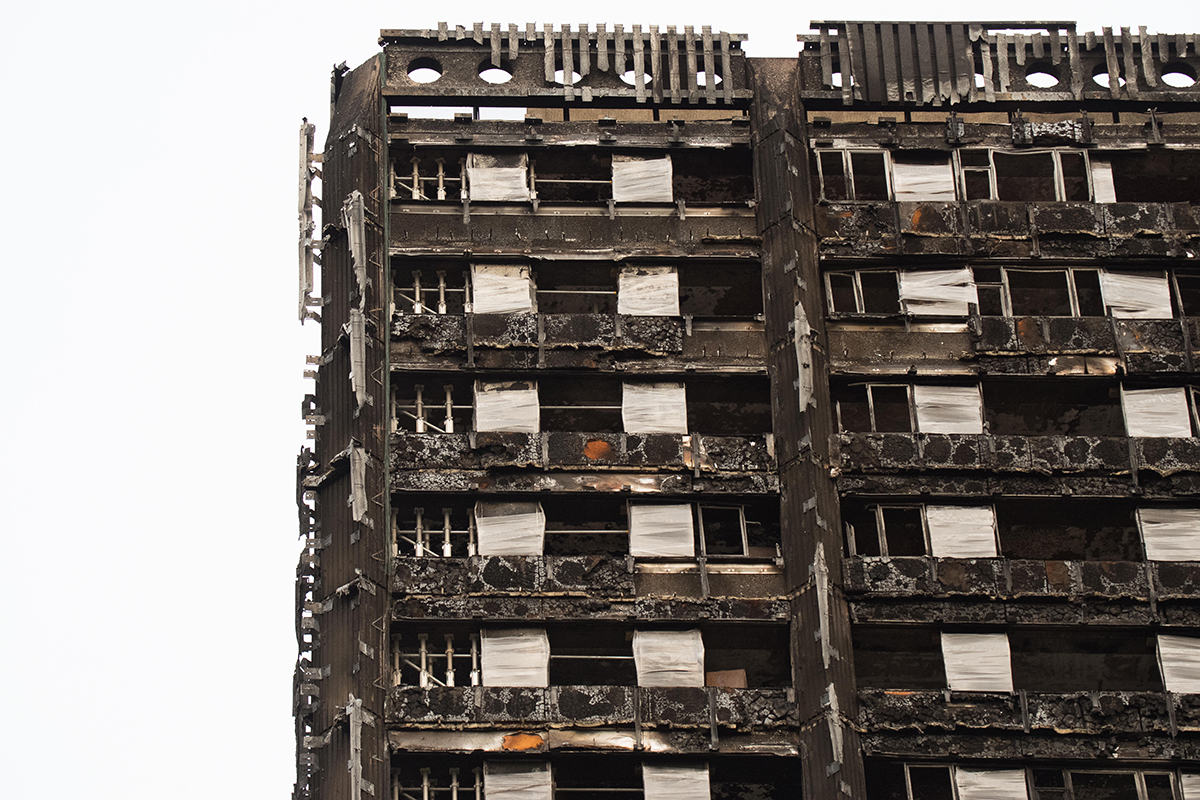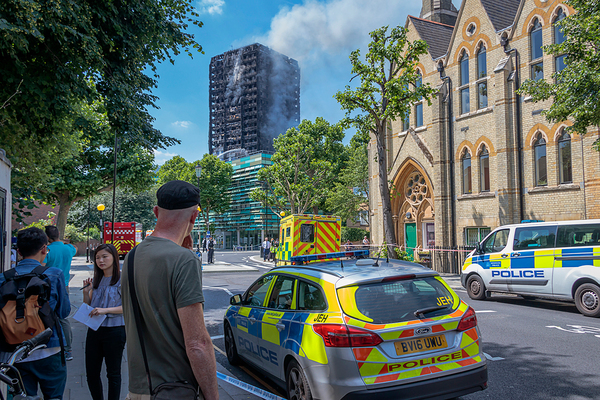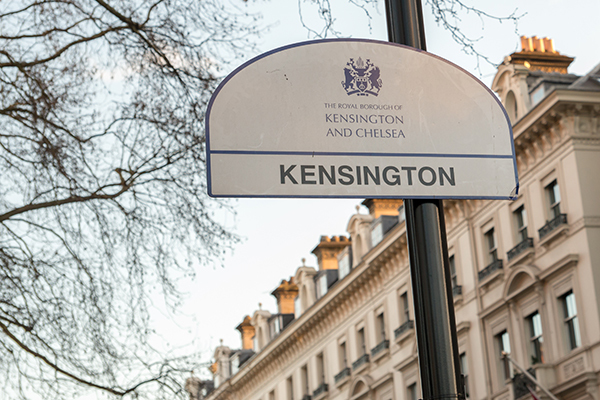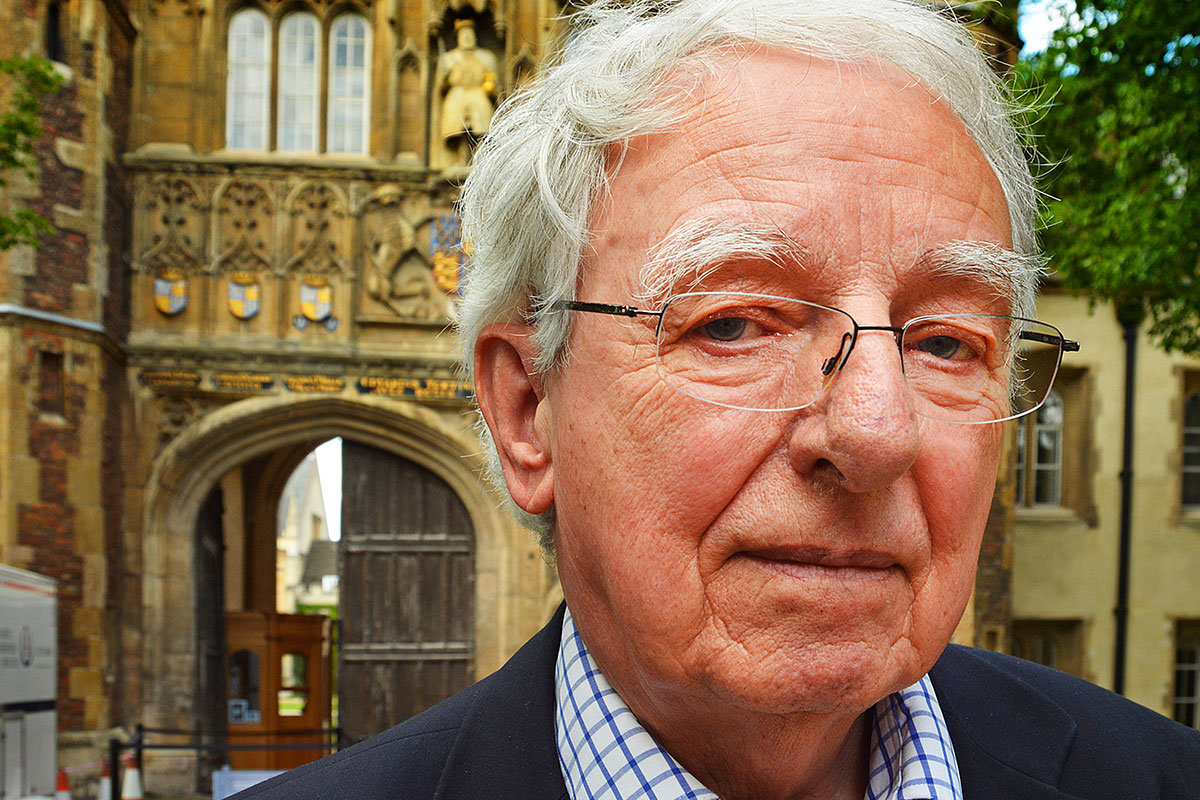You are viewing 1 of your 1 free articles
We speak to Grenfell survivors awaiting rehousing
Ten months after Grenfell, Danielle Aumord talks to survivors from the tower and those evacuated from nearby homes to find out if they have been rehoused yet
Survivors of the Grenfell Tower fire and those living nearby are awaiting rehousing (picture: Alamy)
Ten months on from the deadly blaze at Grenfell Tower, the process of rehousing survivors is still painfully slow.
At least 256 people, or 138 households, survived the fire but lost their homes, as did some of the residents in the low rises surrounding the tower. Kensington and Chelsea Council has told Inside Housing that, for various reasons, the original 138 households have now split into 211. Of these, 192 have to date accepted the offer of a home, this includes 67 who have moved into an interim home and 66 into a permanent home.
The council has committed £235m from its reserves to rehouse these families, buying 307 homes from the private market.
Kim Taylor-Smith, deputy leader of the council, says: “We will continue to move at the pace of individuals and families, because we believe that those who have been through such trauma and tragedy should not be rushed into making important decisions which will impact the rest of their lives.”
Inside Housing talks to some of the survivors (see boxes below) and evacuees to hear their housing experiences since the fire.
We spoke to those from both Grenfell Tower and Grenfell Walk – the set of flats connected directly to the bottom of the tower.
Evacuees from Grenfell Walk are being treated the same as direct survivors from the tower in the way that they are being allocated rehousing points because they also can’t return to their homes – although their flats weren’t burnt.
Mahad Egal
“The places that we’ve been offered so far have been shambolic,” exclaims Mahad Egal, 30. Mr Egal spoke with Inside Housing in a cafe near Latimer Road tube station, walking distance from where the charred remains of Grenfell Tower still stand. Since the fire, he suffers from post-traumatic stress disorder and as a result finds crowded places difficult to cope with.
He also confides that since the blaze, it’s been difficult for him to think straight: “We’re f****d in the head right now, we can’t even remember that we have a meeting tonight. I almost didn’t come into this cafe because there were too many people in here.”
We are speaking just over eight months after the fire. Mr Egal has been offered two properties outside the borough, another that had drainage problems and one that was not on the ground floor. “We need a ground floor property after the trauma of having to escape with the kids from a higher level flat,” he explains.
Mr Egal escaped the fire from his fourth-floor flat at Grenfell with his wife, Jamie, 20, and their two children aged two and four.
As he speaks to Inside Housing, it becomes clear that a miscommunication has occurred with the council over rehousing. “After we found out about the £235m procurement budget, the rehousing process was taking so long so out of frustration we asked the council if we could go around and look for homes ourselves. Kim Taylor-Smith said ‘Yes’, [and told us] these are the budgets for one bedrooms, two bedrooms, three bedrooms, etc.
“So we went around gathering up information on empty properties from local estate agents. We went and did the council’s job for them but they haven’t offered us to be rehoused in those properties. They simply bought them and then uploaded them to their housing bidding system.”
"It’s difficult living where we’re staying now because sometimes people book the other serviced apartments in the building for parties"
When Inside Housing approached Kensington and Chelsea Council for comment, it denied enlisting the help of survivors to find homes. A spokesperson says: “Residents have never been asked to source properties and liaise with estate agents.”
The family have lived in seven different locations including hotels since the fire. They are now in a serviced apartment in Kensington: “Eight months onwards, we still haven’t got a home. We had at least 10 housing assessments but what we specified we needed still didn’t match the properties they offered us.
"It’s difficult living where we’re staying now because sometimes people book the other serviced apartments in the building for parties. It’s noisy, it’s still kind of like a hotel. It’s difficult to knock on someone’s door, a group of girls, and say to them please can you turn it down.”
Mr Egal is visibly angry and shaking as he speaks. He has the hood on his jacket up and often buries his head in his hands. “Our kids don’t have a routine, they’re going to sleep at all different times, 6pm, 7pm, 8pm. Sometimes they even have to come with us to our residents’ association meetings at 9pm,” he says.
At the time of the interview, Mr Egal is on his way to the Kensington town hall to address a number of issues. “The financial support we were getting has been cut off without prior assessment or prior notification,” he says. (Inside Housing asked Kensington and Chelsea about this, but not received a direct reply.)
Understandably, many survivors from the fire and even those who witnessed the event that night are still too traumatised to work, and the financial support including food and childcare allowances was found helpful by people evacuated to hotels.
As we sit in a cafe by the estate where the charred remains of the tower still stand, Mr Egal tries to call the ‘Care for Grenfell’ telephone line.
It’s mid-afternoon on a week day and it’s ringing out. He tells Inside Housing that his key worker hasn’t responded to his messages for three days. Again, Inside Housing put this to the council press office, but did not receive a reply.
When we catch up with Mr Egal just before publication of this story, he has been offered a property that he likes and is suitable for his family, but is still stuck in emergency accommodation as his solicitor negotiates the terms and conditions of their tenancy agreement. “We’re not moving until the paperwork is right,” he says.
Christo Fairbairn
Christo Fairbairn, 41, lived on the 15th floor of Grenfell Tower by himself for two years. He was one of the last people to escape the fire, managing to get out at around 4am. He says: “I can’t tell you how many bodies I had to step over. All I remember is that they felt soft. I recognised some of the faces of my neighbours. I’m still traumatised. I’m feeling better now that I’m out of hotels but I still don’t feel 100% right.”
Mr Fairbairn moved between six different hotels for six-and-a-half months after the tragedy. Now he’s in temporary accommodation: “You need a roof over your head to help you with your mental state. If you don’t have your mental health right, you’ll feel beat up.”
As he talks, he fidgets a lot. It’s clear that he’s still nervous after the fire and that hotel life doesn’t suit him: “There was too much movement, people coming and going. There’s no privacy in a hotel; other people have the keys to your room, anyone can come in. I’m now in a temporary flat in north Kensington and I feel much better.”
“You need a roof over your head to help you with your mental state"
He tells Inside Housing that he had to request a new case worker: “I was being shown unsuitable properties. One needed renovation, it had no flooring; another had a leak from the property next door causing mould and damp, and the other one was outside Grenfell Tower.”
Inside Housing asks Kensington and Chelsea about this and a spokesperson says: “The council has staff working around the clock, doing everything they can to rehouse families as quickly as possible. We’re leading the biggest house-purchasing programme by any local local authority in recent history. The council has already spent £235m to secure 307 homes, so that people have maximum choice available.”
Mr Fairbairn’s temporary flat has two bedrooms so that his 13-year-old daughter can also come to stay with him. “Right now I’m thinking about my daughter, she’s my main concern,” Mr Fairbairn says. “I’m worried about everything to be honest, including the type of tenancy they might offer me but thank God for my solicitor. I’m blessed to have him, he’s really helping me, he’s representing quite a few of the survivors from the tower. We’re lucky to have him.”
Sakina*
Sakina is 30 years old and she’s lived at Grenfell Walk for 13 years, since marrying her Moroccan husband. Her 12-year-old daughter has grown up there, along with her seven-year-old son.
At the time of the fire she’d just had a baby boy. He’s learned how to crawl while they’ve been living in a hotel, waiting to be moved into their new home. Luckily for her, she’s already seen the home that been bought for her to be rehoused in. “It’s a house. When the council was looking at purchasing it, they called me to ask me to see it, to find out if we’d like to be rehoused there.”
Sakina is small, dressed in white trainers and a black padded parka coat. We get a coffee together on the main road in Ladbroke Grove. She has a sweet but determined way about her: “I’m trying to help other people, although my housing situation seems sorted now. I’m trying to help the other residents to also sort out their housing; the ones don’t know their rights, who don’t feel very confident or can’t speak English.
“I’ve also been trying to help the council to look for properties to buy from the procurement budget, but I’ve had to explain to them that we can help them but we can’t actually do their job for them,” she adds.
It’s been difficult for Sakina and her family – five of them living together in a hotel room. Her daughter has been suffering from panic attacks. “She lost friends, she’s grieving. But as a child, she doesn’t understand what she’s feeling. She hasn’t had her own space. I’m hoping that now that she’s going to have her own room she’ll get better,” Sakina says.
"I’m trying to help the other residents to also sort out their housing"
It’s clear that Sakina is also still feeling the trauma of that night’s events. She wrinkles her face as she talks: “There were so many disabled people, elderly people, people on crutches and in wheelchairs – people who should have been housed in a ground-floor property. We were trying to phone people still in the tower. These are human beings not animals. We were trying to help them to get out as well as trying to help ourselves.”
Sakina feels confident that moving into a permanent home will help their recovery. But, like many of the evacuees, she does have questions to ask about her new tenancy agreement. “For some reason we’re being rehoused with a tenancy agreement with a housing association but it’s actually the council that are buying the property for us to be rehoused in,” she says. “I don’t get that, I don’t understand why we’re not simply staying as Kensington and Chelsea Council tenants with the same contract. I was a secure lifetime tenant but now I’ll be an assured lifetime tenant.
"I’m not sure what the difference is but I’m going to sit down with my solicitor to go through the contract they’re offering us with a fine tooth comb to make sure that I fully understand everything.”
A Kensington and Chelsea Council spokesperson says that any resident accepting a council or housing association property will be offered a lifetime secure tenancy.
At time of publication, Sakina has signed her tenancy agreement and is the process of moving with her family into their new home.
*Sakina’s name has been changed.
The Paper Trail: The Failure of Building Regulations
Read our in-depth investigation into how building regulations have changed over time and how this may have contributed to the Grenfell Tower fire:
Never Again campaign
Inside Housing has launched a campaign to improve fire safety following the Grenfell Tower fire
Never Again: campaign asks
Inside Housing is calling for immediate action to implement the learning from the Lakanal House fire, and a commitment to act – without delay – on learning from the Grenfell Tower tragedy as it becomes available.
LANDLORDS
- Take immediate action to check cladding and external panels on tower blocks and take prompt, appropriate action to remedy any problems
- Update risk assessments using an appropriate, qualified expert.
- Commit to renewing assessments annually and after major repair or cladding work is carried out
- Review and update evacuation policies and ‘stay put’ advice in light of risk assessments, and communicate clearly to residents
GOVERNMENT
- Provide urgent advice on the installation and upkeep of external insulation
- Update and clarify building regulations immediately – with a commitment to update if additional learning emerges at a later date from the Grenfell inquiry
- Fund the retrofitting of sprinkler systems in all tower blocks across the UK (except where there are specific structural reasons not to do so)
We will submit evidence from our research to the Grenfell public inquiry.
The inquiry should look at why opportunities to implement learning that could have prevented the fire were missed, in order to ensure similar opportunities are acted on in the future.














